January 2009 (Part 1)
SELECTION OF QUESTIONS AND ANSWERS

Happy New Year
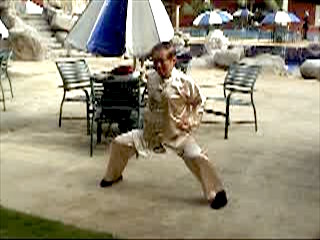
The horse stance taught by Grandmaster Wong in the early days was low. He realized that if the horse stance was low, it would lock up energy at the thighs. Hence, later his horse stance was higher, like the one shown above, which enabled energy to be focused at the dan tian as well as root the practitioner to the ground.
Question 1
I want to thank you for again taking the time and energy to travel to the US to spread the Shaolin arts. The kung fu course was wonderful, and I really enjoyed the new sequences.
— Adam, USA
Answer
Teaching that one-day course in Gainesville created history. The four new combat sequences are remarkable. Many martial artists will find it hard to believe that these four sequences can enable a practitioner to handle any attacks covering all the four categories of striking, kicking, felling and gripping. And the course participants learn them in just one day!
I remember that a few years ago when I was teaching chi kung in Portugal, a few students who had learnt kungfu before asked me to teach Shaolin Kungfu too. I replied that it was not possible to teach Shaolin Kungfu well in a few days.
Yet, in August this year we had a very successful five-day regional Shaolin Kungfu course in Lisbon. Your sipak, Dr Riccardo, told the class that it was a dream come true, reminding them of my unwillingness to teach Shaolin Kungfu in such a short time period a few years ago.
Now we had a one-day Shaolin Kungfu course in Gainesville, Florida in November! And it was comprehensive, covering all important aspects of kungfu training, including stances, basic forms, internal force, combat application and kungfu philosophy. More significantly, despite that the class ranged from beginners' to advanced levels, all the participants did well. Of course, your sifu had done very good work in laying the foundation.
At the course I mentioned that the participants had learnt in just one day more than what many other kungfu practitioners had leanrt in 10 or more years. Understandably, many people would think me boastful or talk non-sense. But it was true. How many other kungfu practitioners with more than 10 years' experience, for example, can develop internal force or use kungfu forms for free sparring?
Question 2
The lower stance seems to build more jing and I've noticed my muscles are becoming more defined in both my lower and upper body. While it is more difficult to stay relaxed in the stance, I seem to build more force in a shorter period of time during One Finger Shooting Zen practice.
Answer
Your observation is correct.
I was glad to see how your classmates practice the Horse-Riding Stance, as it highlighted for me an interesting issue in our school which I would address again in due time.
There is a healthy difference of views in our school regarding how low the Horse-Riding Stance should be. If you look at pictures of how I performed the Horse-Riding Stance in my earlier years, like those found in my book “Introduction to Shaolin Kung Fu”, for example, my stance was low, with my thighs almost level with the ground. That was how my early disciples, like your sibak Kai, learned from me.
Later I discovered from direct experience that if I raised by stance higher to assume a pyramid rather than a square shape, chi flow was better, resulting both in a firmer stance as well as more internal force gathered at the dan tian. It flashed across my mind why pictures showed great kungfu masters performing their Horse-Riding Stance relatively high in their later years. Sifu Lam Sai Weng in his classics, “Taming the Tiger” and “Tiger-Crane”, was a good example.
I then shared my new discovery with our instructors and students, which eventually resulted in some difference of views between my earlier students and latter ones regarding the height of the Horse-Riding Stance. However, height is relative. What is high to some may be low to others.
Nevertheless, in my travels I have found that the Horse-Riding Stance practiced by our Shaolin Wahnam students now is generally a bit high. If they can lower it, it would be better, but they should do so without feeling tensed, and certainly not to such an extent that their stance resembles a square.
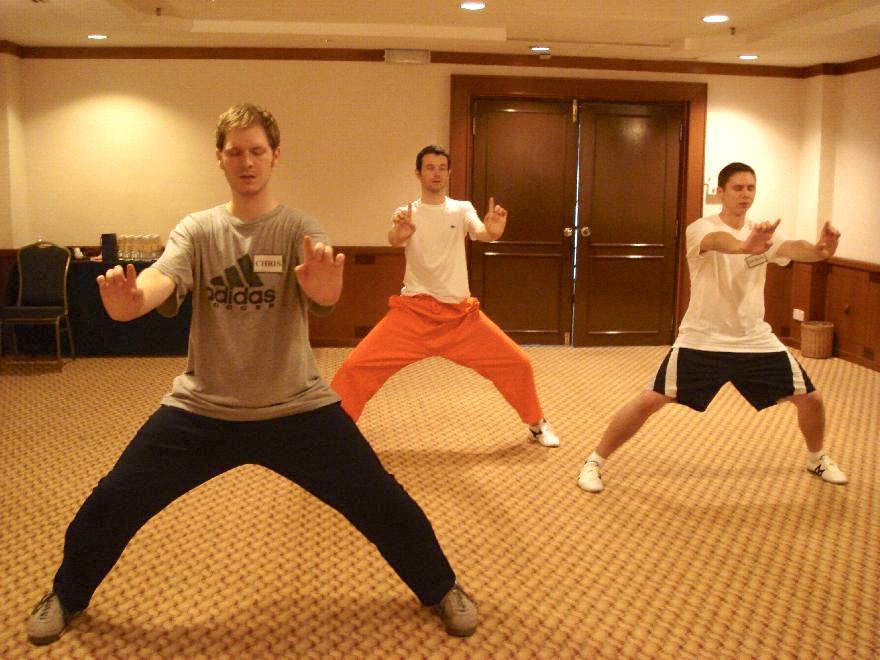
Nevertheless, Grandmaster Wong later discovered that a pyramid shape horse stance would be more effective in developing internal force. Hence the horse stance became higher, as shown here by Chris, Michael and Thomas at an Intensive Shaolin Kungfu Course.
Question 3
Since the course, I've thought of many questions that I wished I'd asked when you were here. A couple of them are practice related, but one is purely intellectual curiosity that is far beyond my current level. As such, if you feel it inappropriate to answer, I completely understand and appreciate everything you've already shared. Thankfully, since I've had excellent instruction, I do not let this curiosity interfere with my practice.
Answer
One of the many reasons why we can attain very good results, and at a relatively short time, is that we encourage questions. I carry on this tradition from my sifu, that is your Sitaigung Ho Fatt Nam.
My sifu often told me, “Ask any questions and I shall answer them. If I don't know the answer, I shall tell you I don't know the answer, and that is the answer.” I benefited a lot from asking my sifu. Hence, I am sure many of our Shaolin Wahnam members will find it amusing when some distractors in our Shaolin Wahnam Discussion Forum accused us of being a cult and would not tolerate any questions.
Nevertheless, there are also occasions when we tell our students not to ask any questions. Such occasions are common during my courses, when I want to lead course participants into Zen or a chi kung state of mind to perform some high level skills like directing chi to certain parts of the body or expanding into the Cosmos.
Asking questions at such times would bring the participants out of their heightened level of consciousness resulting in their inability to perform such skills. There are also occasions when we ask students to stop asking questions, like when they intellectualize instead of practice.
Of course, students must ask questions in a respectful manner. Questioning here is to find out. Questioning in a sense of defiance, and questioning the authority or competence of one's teacher are not tolerated in our school. The content as well as the manner of your questions as shown here are exemplary.
Question 4
The first question deals with sutra recitation. I've been doing the recitation practice outlined in the Complete Book of Zen. If someone can only hold a full lotus position only with a pillow beneath their butt, is it preferable to use another position such as kneeling until the legs are flexible enough for the lotus without support?
Answer
A full lotus position even with a pillow beneath their butt is better than any other positions, though any positions can be used as long as they make you comfortable.
It is recommended to kneel or prostrate before the Buddha, Bodhisattva or any deity to pay homage and show gratitude before and after the sutra cecitation or chanting. But kneeling may not be necessary during the recitation or chanting itself. Why?
It is because sutra recitation or chanting is an act of cultivating blessings, for the cultivator himself and for others. It is not an act of worship, as it may be commonly mistaken to be. In other words, when we recite sutras we cultivate a lot of blessings, and usually we share or even give away totally the blessings so acquired to others, including strangers and non-human beings whom we may not know.
Why is reciting sutras an act of cultivating blessings? It is because the sutras are the direct teachings of the Buddha word by word. When we recite sutras we help to preserve and spread the Buddha's teachings so that a lot of people and other beings can benefit. Indeed, other beings, including gods, may be around to listen and benefit from the sutras when you rectie them, though you may not be aware of their presence. Sharing spiritual teachings is the highest form of charity, higher than providing service and giving money.
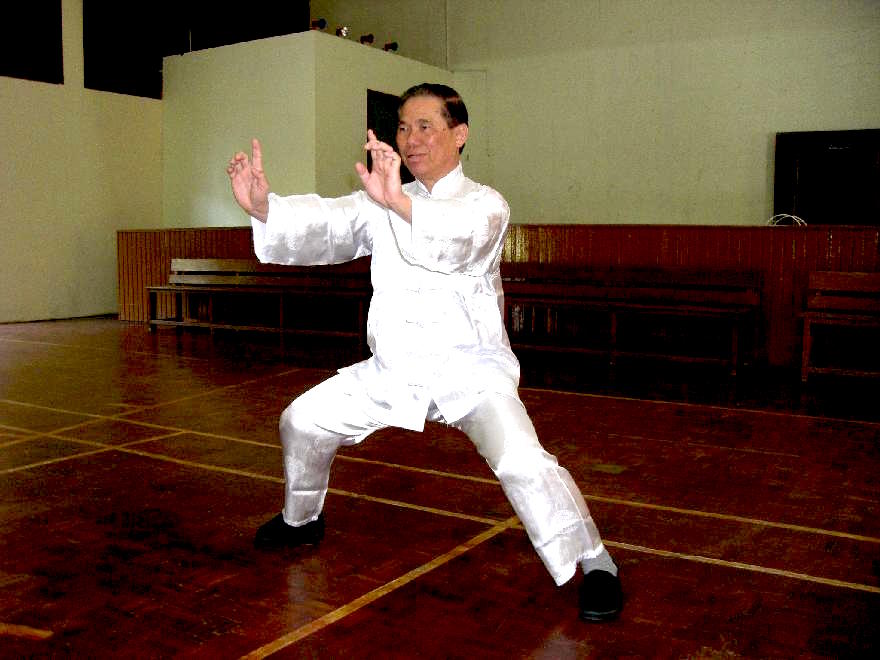
As you chi sinks lower into your dan tian, you should assume a height of the horse stance as shown here by Grandmaster Wong
Question 5
My statue of Guan Yin was originally holding a water vase that got broken off in a move. I really like the statue, but because of this does it need to be replaced (is it disrespectful to use a statue with a part broken)?
Answer
It is advisable to replace it. The breaking could be the result of some divine force acting on your behalf to protect you, without you conscious knowing. Obviously a broken spiritual item has less power than an intact one.
It is wonderful that your desire to replace the partially broken statue is due to your sense of respect. In reality, respect is not an issue here. Of course this does not mean that respect is not necessary. This is another issue.
The issue here is one of spiritual power and protection. Due to your respect for the great Guan Yin Bodhisattva, you wish to replace the statue, which, without your knowing had I not explained it here, will restore the spiritual power that protects you. This is an example of good thought generating good result.
Question 6
I've read on an online source that if you offer water at the start of the session, that drinking it afterwards will have healing properties. What are your thoughts on this practice?
Answer
I don't know the answer here. But personally I do not drink the water that is offered to the Bodhisattva or any deity. If I want to have water with healing properties for myself or anybody, I use some separate water, not the one offered to the Bodhisattva or deity.
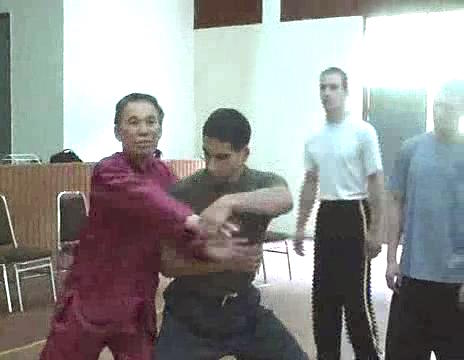
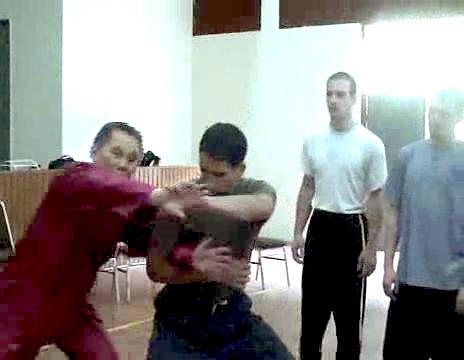
Shaolin Kungfu is both extensive and deep, as shown in this combat application at the Special Chin-Na Course in Sabah in June 2008. Andres grips Grandmaster Wong's both wrist and is about to elbow him. How would you respond?
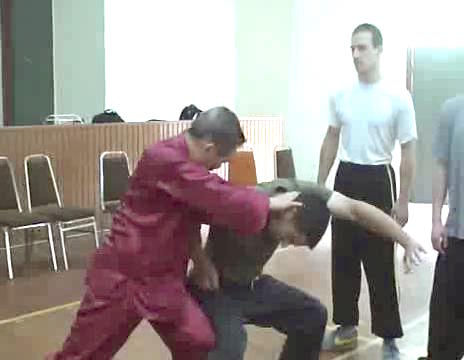
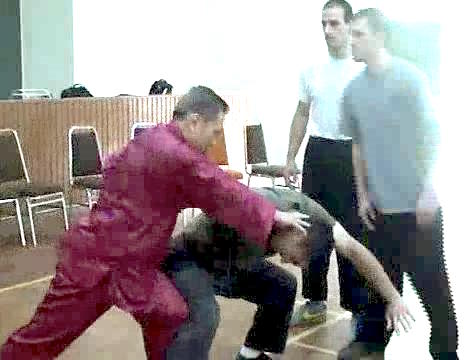
Grandmaster Wong shifts his body to avoid the elbow strike, turns his right wrist and left arm to release the double grip, then counters with the pattern called "Eagle Claws Catch Dragon". You can view the movements in the video series here.
Question 7
Another question I have relates to the discussion about One Finger Zen or Dim Mak that took place in my living room. You mentioned that when you tapped Valerie on Bai Hui, it was done at the golden moment. Looking back I realize when you demonstrated the application with me, had you dotted me it would also have been at the golden moment.
How much impact does striking at the precise golden moment have on the effect of energy dotting? As I am a long way from this, I am perfectly happy letting the question go if it's not information you would like to share at this time. In fact, that's exactly what I'm going to do, and if a response comes, it will just be an unexpected present!
Answer
Golden moment here refers to the instant when an opponent's movement is spent and his new movement has not started. It does not refer to striking relevant vital points at the time those points are most vulnerable according to the circle of energy flow.
In Valerie's case, after he kicked he dropped himself forward with the crown of his head exposed. I tapped his bai hui vital point before he could move his head away. In your case, I dotted (even a few inches away) your tan zhong vital point as I deflected you punch when it was spent, and before you could change into another move.
As the golden moment refers to the timing of the technique and not the timing of the striking moment, it affects the effectiveness of the technique but not the impact of the strike. In other words, because I exploit the golden moment in my attack, I can effectively hit an opponent. If I miss this golden moment I may not hit him.
But how badly the hit is does not depend on this golden moment. Had I hit him a second earlier or later, the damage would be the same if I used the same intent and force.
Question 8
I've spent the last 8 days in Frankfurt, training with Sipak Kai. Of course, it is always the most humbling of experiences and richly rewarding.
I have re-realized that a pattern is simply one manifestation of a principle. For example, “Single Tiger Emerges from Cave” is taught at the start as a mid-level defense, but later, with improved skills, it can counter a larger range of attacks and can be used for countless purposes.
This confirmed to me that the pattern or set or style is not always the deciding factor but it is the spectrum of the exponents' understanding and imagination that decides who is better.
For example, I may have 10 variations of “Single Tiger” but you may have 1000! It's the same pattern but you have greater skill that allows greater imagination. Here we put the Art into Martial Artist.
So, with this in mind, I would like to forget my idea of creating a new set for the moment. I would prefer to work on improving my foundation and opening my martial artist's mind to the endless variations and applications of each pattern in the “Cross-Roads”.
I can now see the universal similarities between all good martial arts, and although Shaolin Kung Fu is the best, it requires a good exponent to manifest this truth.
— Sifu Jamie Robson, Scotland
Answer
I am glad that you have deepened your understanding of techniques. But depth is only one aspect of your training.
The other aspect is breadth. It refers to widening the scope of your techniques. Depth and breadth manifest the yin-yang principle of development. If you focus only on depth and neglect breadth, your development is incomplete. You may end up viewing kungfu from a narrow perspective.
Although you are good compared with many other martial artists, you still have much to learn in our Shaolin Wahnam training programme. At this stage of your development, it is wiser for you to focus on breadth, but without neglecting depth.
Actually you have been doing well in this aspect. Your sparring with martial artists of different styles is a good example. You have laid the foundation. What you should do is to bring this aspect of your training to a good conclusion.
An excellent way is to compose a set that sums up your experiences with these martial artists. The learning and training you had from me at the Specialized Shaolin Kungfu Course a few years ago would be very useful for you for this purpose. Composing your set or sets will also gives you many opportunities to deepen your skills and understanding of techniques. It is also a lot of fun.
LINKS
Selected Reading
- The Standard of Lion Dance We Aim to Attain
- Life is to Live It
- Why Can't Kungfu Practitioners Spar with Kungfu Patterns?
- Taijiquan Four-Sequence four-Attack Set
- What is Genuine, Traditional Taijiquan
